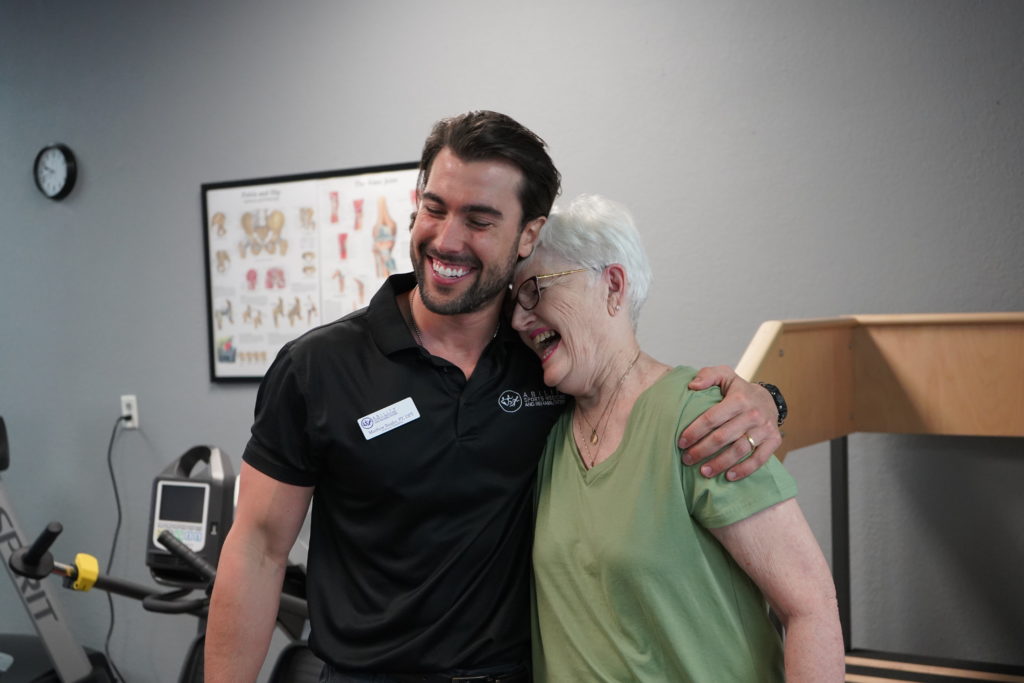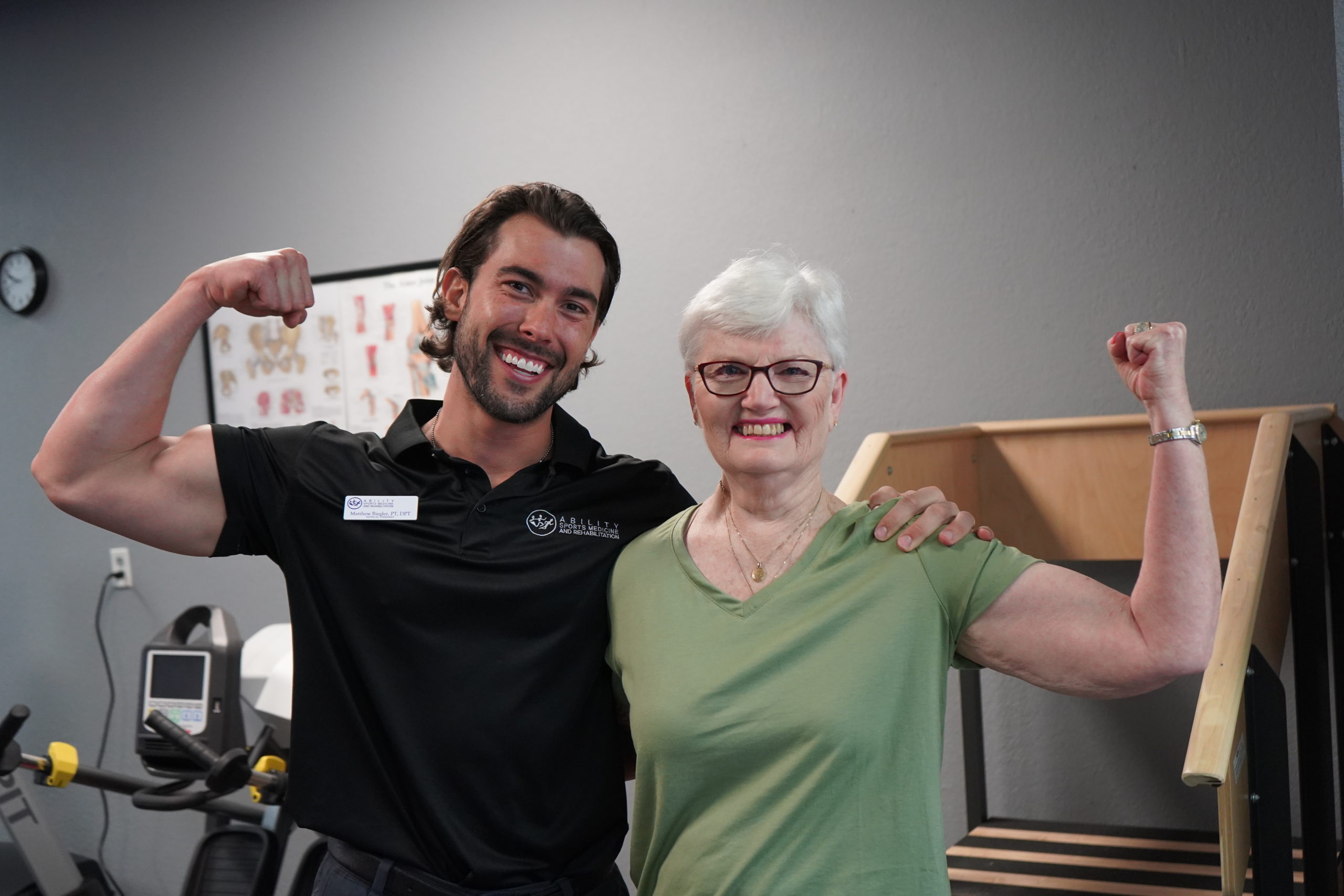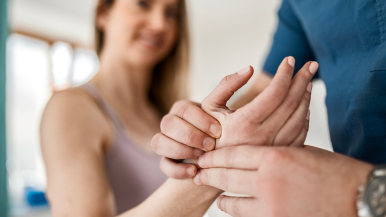- What is physical therapy?
- How does physical therapy benefit the low back?
- Can physical therapy help me in other ways?
- What can I expect from my physical therapy appointment?
Low back pain is one of the most common complaints of Americans aged 60 and over. Age-related changes such as spinal and bone degeneration, physical inactivity, genetic issues and more can create low back pain that is far too common. In fact, studies show the incidence of musculoskeletal pain in this age group is as high as 85%.
Rebecca B. was a patient at Ability Rehabilitation for about six months as she sought to find relief from chronic low back pain. She was positive about her experience, stating, “Everyone here has been fantastic.”
What Is Physical Therapy?
Physical therapy is a non-invasive treatment to help patients regain their optimum body functioning and reduce chronic pain and discomfort. This treatment can be used to help people:
- Maintain or recover from a chronic health disorder
- Regain physical function after an injury or surgery
- Prevent future injury
- Relieve pain
Physical therapists work in conjunction with your primary doctor to rehabilitate the body to regain as much of mobility and function as possible. This is particularly important if you’ve experienced injury or a surgery such as a hip or knee replacement. It’s the job of a physical therapist to help you get back to doing what you love again, and these professionals undergo extensive training in medical and biological sciences as well as attaining a high level of skills in ergonomics and the body and its movements and structures.
How Does Physical Therapy Benefit the Low Back?
 Rebecca, like many Americans, suffered from low back pain. Physical therapy helped her strengthen her muscles, decrease pain, and improve her mobility. The Spine-Health website points out there are two primary components of physical therapy to remedy back pain. They include passive therapy and active exercise to reduce the pain. This may include:
Rebecca, like many Americans, suffered from low back pain. Physical therapy helped her strengthen her muscles, decrease pain, and improve her mobility. The Spine-Health website points out there are two primary components of physical therapy to remedy back pain. They include passive therapy and active exercise to reduce the pain. This may include:
- Core strengthening to improve your posture
- Ice or heat packs
- Iontophoresis, which is a method of delivering steroids through the skin to the affected area
- Low-impact aerobic conditioning
- Stretching the back with gentle exercises
- TENS units, which uses electricity to “tingle away” the feeling of pain
- Ultrasound, or a deep heating of the muscles where sound waves penetrate the muscles and stimulate healing
Interestingly, in many cases, doctors often are often not sure what causes low back pain. Many times, there is no fracture or inflammation causing the problem. Non-specific low back pain is a common diagnosis, particularly in older Americans. Doctors often use magnetic resonance imaging (MRI) to rule out disc degeneration, which is also very common in the elderly. Arthritic joints as well as a condition called myofascial pain, which can cause pressure on muscle trigger points, can create the low back pain.
The exercises that Rebecca undertook as part of her physical therapy helped strengthen the core muscles around her back, making her more aware of her posture. She says, “My muscle strengthening here has improved greatly.”
Can Physical Therapy Help Me in Other Ways?
There are positive side effects from undergoing physical therapy that can benefit more than your lower back. Rebecca had the added benefit that the physical therapy also, “helped me to be careful when I’m walking and not to stumble and fall.”
Falling is an increasing concern as we age. The National Council on Aging reports, “Falls are the leading cause of fatal and non-fatal injuries for older Americans. Falls threaten seniors’ safety and independence and generate enormous economic and personal costs.”
Each year, falls cause more than 2.8 million injuries; that’s every 11 seconds in this country. Some common problems that increase the risk of falling for seniors include:
- Balance and coordination issues
- Certain medications
- Vision problems
- Weak leg muscles
Physical therapy, in addition to reducing Rebecca’s pain, helped her with balance and coordination. She reports, “My time here at Ability has allowed me to walk up and down steps a lot better.”
A physical therapist can create exercise programs designed to specifically address the potential for falling with weight training, obstacle courses, and walking sessions to increase endurance.
Physical therapy can also help with improving how you pick up objects, by lifting correctly with your knees and not your back. It can strengthen muscles and teach you exercise you can continue to do at home, so that you’re less likely to pull a muscle or fall as you’re trying to undertake normal everyday tasks that get harder as you age.
Rebecca said one of the positive side effects of undergoing physical therapy for her low back pain was that, “It’s helped with my walking and carrying. Even simple things, like picking up laundry, it has helped greatly.”
What Can I Expect from My Physical Therapy Appointment?
 If you’re having chronic back pain or need to improve your mobility after surgery or an illness, your doctor may prescribe physical therapy. In the State of Florida, you can also see a physical therapist without a referral. The initial evaluation will include discussion of your condition, and an assessment of your current level of functioning and how it has impacted your life. Some typical questions may include:
If you’re having chronic back pain or need to improve your mobility after surgery or an illness, your doctor may prescribe physical therapy. In the State of Florida, you can also see a physical therapist without a referral. The initial evaluation will include discussion of your condition, and an assessment of your current level of functioning and how it has impacted your life. Some typical questions may include:
- How did the problem begin?
- What was your mobility like before the injury or problem?
- How often do you suffer from symptoms?
- Has the problem changed or gotten better or worse?
The physical therapist will review the doctor’s tests or other available information and do a physical exam to check on your function. Some common measurements that will be taken as part of the exam include:
- Understanding your ability to balance
- Evaluation of functional mobility
- Neurological screenings
- Palpation
- Measuring range of motion
- Strength testing
These tests will all be discussed with you in advance so you know what to expect. The physical therapist will then create an individualized treatment plan to help your specific problem.
Rebecca gave the best endorsement for the work we do at Ability Rehabilitation, “I’ve already told one friend that they’re great.” She said, “Whatever you have, they’ll fix. If you’re in need of physical therapy, this is the place to come.”



